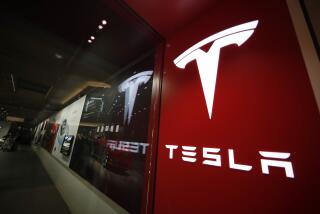Tesla reports small growth in deliveries for the third quarter. Wall Street isn’t pleased
- Share via
Tesla’s stock price took a dive Wednesday afternoon after the electric car maker announced nearly flat deliveries for the third quarter.
Deliveries of the Model 3, on which Tesla has hung its future, were up 2.6% over the second quarter, to a total of 79,600. That’s 42% higher than the 56,065 Model 3s delivered in the third quarter of 2018 — and came close to analysts’ consensus estimate of 80,200 deliveries.
For the record:
4:43 p.m. Oct. 2, 2019An earlier version of this report referred to a full-year production guidance of 360,000 vehicles. That is the guidance for deliveries.
Deliveries of Tesla’s higher-priced, higher-margin older models — models S and X — dropped by 250 vehicles from the second to the third quarter, to 17,400. That’s down 37% from the 27,710 S and X models delivered a year earlier. That put the company within spitting distance of meeting the low end of its delivery guidance of 360,000 for the full year.
The company delivered a total of 97,000 vehicles, up 2% over the second quarter. That came in at the high end of the 88,000 to 98,000 deliveries that analysts had expected, according to Factset.
Tesla’s shares are down 23% for the year in part because its Model S and X cars are beginning to show their age.
Tesla produced 96,155 vehicles at its Fremont, Calif., factory in the third quarter.
Even at that pace, Tesla is a long way from the 500,000 vehicles Musk promised early this year to produce in 2019. At one time, Musk had talked about building a million cars a year by the end of 2020.
In the hour after Tesla announced its numbers, its stock price fell as much as 6%. It was down 3% at 5:30 p.m. EDT. The company has a market value of $43 billion.
“Reaching its production goals will be a Herculean task,” said Wedbush analyst Dan Ives. “Tesla needs to catalyze demand.”
In an email, Tesla bull Ross Gerber, of the Santa Monica investment firm Gerber Kawasaki, offered a more positive assessment:
“Great quarter. Just a little light on Model 3 production but good model S and X sales,” Gerber wrote. “This will be better for margins. Very excited the issue is not demand as demand is still bigger than supply.”
While deliveries rose, the company faces revenue and margin problems. The aging Model S sedan and Model X SUV — whose prices can easily exceed $100,000 — deliver higher profit margins than the Model 3. As the less expensive Model 3 gains favor against the S and X, the company’s average selling price declines, affecting revenue growth. According to Factset, Tesla’s average selling price for all models declined from $97,600 in December 2018 to $55,600 in this year’s second quarter.
The company will report third-quarter financial results in about a month. Although flat sales don’t bode well for profits or cash flow — Tesla has shown only three profitable quarters since it went public in 2010 — the company said Wednesday that “Tesla vehicle deliveries represent only one measure of the company’s financial performance and should not be relied upon as an indicator of quarterly financial results.”
The company also sells storage batteries and solar roof panels.
Elon Musk has a huge financial incentive to turn on full-service driving. But is Tesla anywhere close to ready?
Tesla introduced a driverless feature called Smart Summon last week, which analysts said could free up $100 million to $200 million that could be applied to the revenue line. Over the years, Tesla has taken in thousands of dollars each from customers to reserve “full self-driving” features as they become available. Although that money contributes to cash flow, it doesn’t flow to the revenue and income lines until the features are delivered. The company also sometimes accounts for revenue from energy credits, with amounts that vary by quarter.
The 97,000 figure falls short of the number Musk mentioned in a leaked email to employees last week. In it, he said 100,000 deliveries were possible this quarter. That sent Tesla’s share price climbing.
“When Elon Musk says they are aiming for 100,000 deliveries, you are hoping for 102,000. Not 97,000,” Gene Munster, a managing partner at venture capital firm Loup Ventures, said in an interview with Bloomberg. “This is a credibility hit. This is a textbook example of Elon not being disciplined and having difficulty managing expectations.”
In the second-quarter delivery report, Tesla included the statement “we reaffirm our prior guidance of 360,000 to 400,000 vehicle deliveries in 2019.” That statement did not appear in the third-quarter report.
Bloomberg contributed to this report.
More to Read
Inside the business of entertainment
The Wide Shot brings you news, analysis and insights on everything from streaming wars to production — and what it all means for the future.
You may occasionally receive promotional content from the Los Angeles Times.











